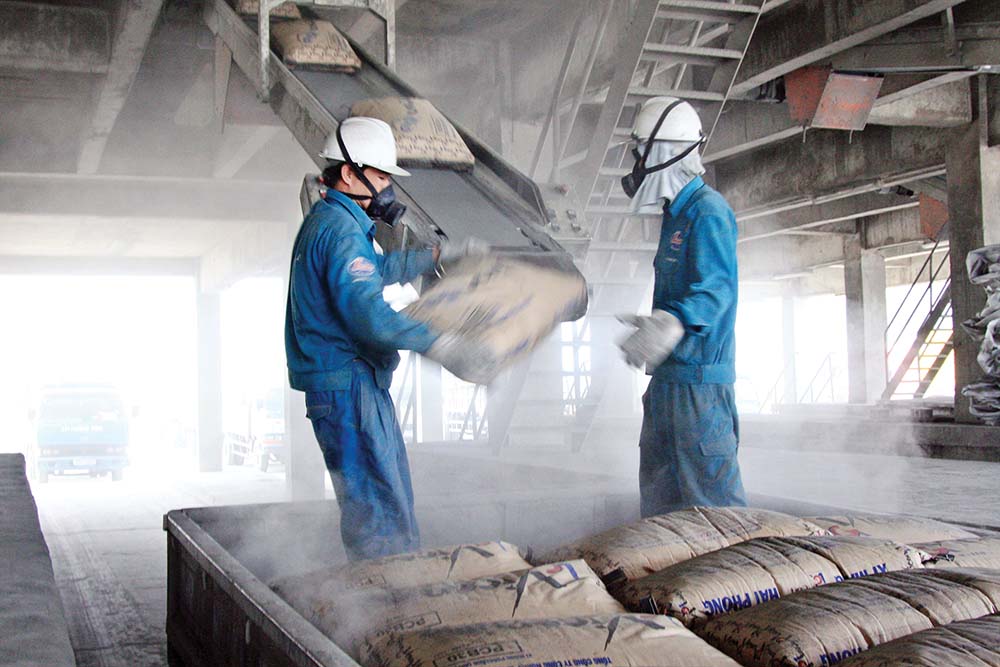In addition to the Xuan Son cement project which is in the investment and construction phase with a plan to operate at the end of this year, the cement industry has 4 production lines with a capacity of 11.4 million tons. Although the investment has been completed, there are concerns that they will not be sold so they have not been put into operation.
 |
| The cement industry is experiencing excess capacity, many units have to limit production. Photo: Duc Thanh |
Slow, but still has new projects
If nothing changes, by the end of this year, the Xuan Son Cement Factory Project ( Hoa Binh ), with a total investment of 5,000 billion VND and a capacity of 2.3 million tons/year, will be put into operation.
The latest information from the project investor, Xuan Khiem Group Joint Stock Company, is that the project has basically completed 97% of the grinding line volume, as well as many other items, with an investment value of about 2,800 billion VND.
Having new projects should be a good thing for the manufacturing industry, but not for cement, because the total designed capacity of the entire industry has exceeded domestic consumption demand for many years now, with a current surplus of about 50-60 million tons, or even more.
The oversupply of cement is even greater, as there has been no industry planning for the past 6 years. It is necessary to review the implementation of planning and licensing for cement projects.
For nearly 3 years now, domestic consumption and export have declined, inventories have increased, up to 42 cement production lines have had to stop operating for 1 to 6 months, some even stopped for a whole year, corresponding to the stopped capacity accounting for 30% of the total designed capacity of the whole industry, or more than 30 million tons. Many factories are on the brink of bankruptcy, so new projects coming into operation during this time only increase the burden of consumption, competition between businesses in the industry is more fierce, many businesses have to sell products below cost.
The "health" of cement industry enterprises has never been as dire as it is now, when financial pressure increases due to large investment loans, and cash flow for production and circulation is not guaranteed.
In addition to the Xuan Son cement project that is in the investment and construction phase, with an operational plan by the end of 2024, the cement industry has 4 production lines with a capacity of 11.4 million tons. Although the investment has been completed, the fear of not being able to sell has prevented them from being put into operation.
Worried that production will continue to expand, while the excess capacity is too large, in recent dispatches to the Government, the Ministry of Construction and the Vietnam Cement Association (VNCA) recommended not to encourage foreign investors to invest in cement projects, and to review investment in cement projects, with the goal of not increasing excess production.
Owning 10 member units, Vietnam Cement Corporation (Vicem) said that in its 120 years of establishment, it has never been as difficult as it is now. “Some production lines in the system of 10 cement enterprises of Vicem have had to stop kilns, consumption is poor, income has decreased, but we are determined not to sell below production cost,” said Mr. Nguyen Thanh Tung, Deputy General Director of Vicem.
At the conference to remove difficulties for cement, steel and construction materials, representing cement enterprises, Mr. Le Nam Khanh, General Director of Viem, directly proposed to the Prime Minister not to attract both domestic capital and FDI capital to invest in cement, in order to reduce pressure on production and business.
According to Mr. Khanh, for the past 3 years, domestic consumption has been around 60 million tons, while the actual capacity is 123 million tons and could be much higher than this number, so where can it be sold?
VNCA statistics show that in the first 6 months of 2024, cement and clinker production and consumption have not improved, only equivalent to last year, with a total output of 44 million tons, factories running at 70-75% of design capacity; consumption of nearly 44 million tons, equal to the same period.
Proposal to bring cement back into planning
Sales revenue plummeted, with some profits decreasing, while others were incurring losses. Dozens of production lines had to temporarily stop production, accept exports below production cost, and financial difficulties were extremely difficult… This is the general situation of cement industry enterprises at this time.
According to the latest report from VNCA, the total number of cement production lines invested nationwide is 92. In the period 2011-2020, massive investment in cement, the whole industry has 26 more production lines, with a capacity of 41 million tons/year, bringing the total number of cement production lines nationwide to 85, with a total designed capacity of more than 104 million tons.
Last year, total cement and clinker production output reached only 92.9 million tons, with the average industry-wide production line operating at only 75% of its total design capacity. Total consumption output in 2023 is expected to reach 87.8 million tons, equal to 88% of that in 2022.
“The cement surplus is even greater, as there has been no industry planning for the past 6 years, and approval is mainly based on local recommendations to the Prime Minister. It is necessary to review the implementation of planning and licensing for cement projects,” Mr. Nguyen Quang Cung, Chairman of VNCA, suggested.
In fact, in 2017, the Law on Planning came into effect, abolishing product planning, including cement products, from which investment in cement production projects was carried out in accordance with the provisions of the law on investment.
Faced with the situation of excess cement production capacity nationwide, leading to difficulty in controlling the supply and demand of cement for domestic consumption and export, the Ministry of Construction recently proposed that the Prime Minister assign the Ministry to study and propose re-establishing the planning of this sector.
“Currently, the pressure on excess domestic clinker production capacity is extremely large, about 50 million tons, while the construction speed is very slow, leading to bad debt pressure in the cement industry that is and will become a burden on the economy. If there is no timely support solution from the State, many businesses will go bankrupt,” the Ministry of Construction is concerned.
Source: https://baodautu.vn/du-an-nganh-xi-mang-cho-thi-truong-d219424.html



![[Photo] Prime Minister Pham Minh Chinh chaired a meeting to evaluate the operation of the two-level local government model.](https://vphoto.vietnam.vn/thumb/1200x675/vietnam/resource/IMAGE/2025/10/29/1761751710674_dsc-7999-jpg.webp)


![[Photo] New-era Party members in the "Green Industrial Park"](https://vphoto.vietnam.vn/thumb/1200x675/vietnam/resource/IMAGE/2025/10/30/1761789456888_1-dsc-5556-jpg.webp)
![[Photo] Fall Fair 2025 - An attractive experience](https://vphoto.vietnam.vn/thumb/1200x675/vietnam/resource/IMAGE/2025/10/30/1761791564603_1761738410688-jpg.webp)



























































































Comment (0)